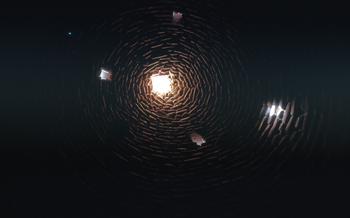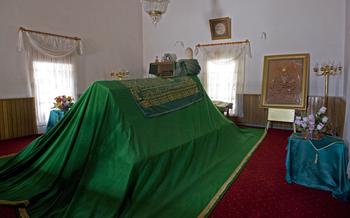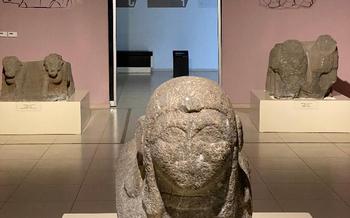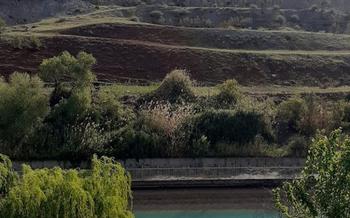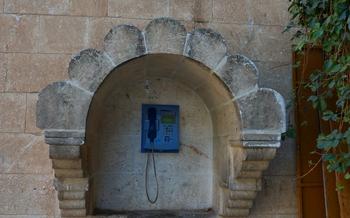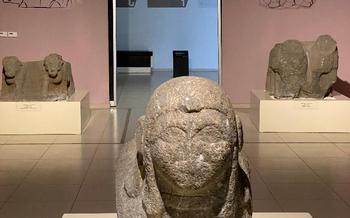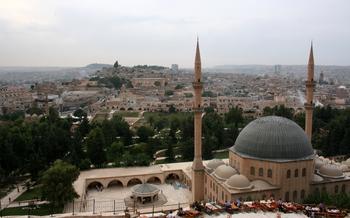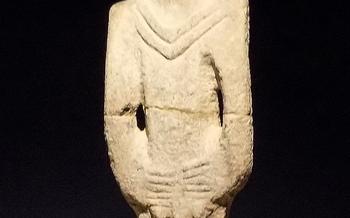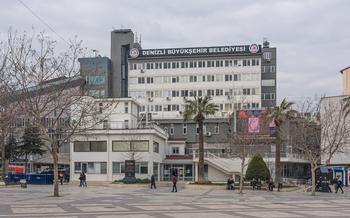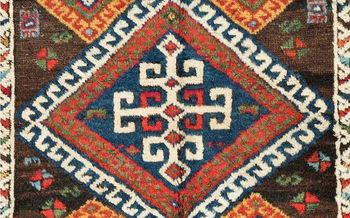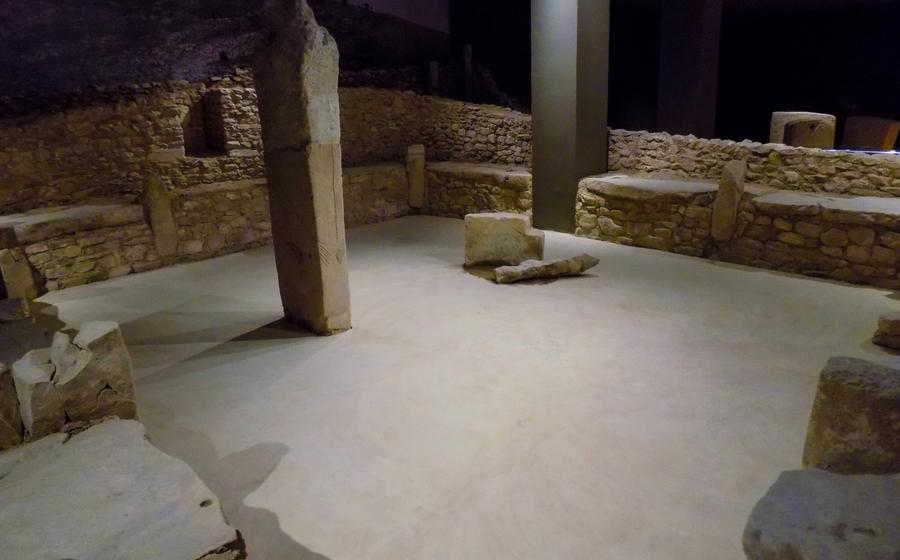
Nevali Çori
- A Monument to the Past: Unveiling the Enigmatic Nevali Çori
- Stepping into Prehistory: Exploring the Ancient Settlement
- Remarkable Artifacts: Glimpsing Life in Nevali Çori
- Unraveling the Mysteries: The T-Shaped Pillars
- A Thriving Community: Subsistence and Economy
- Social Structure and Organization
- Religious Beliefs and Rituals
- Artistic Expressions: Sculptures and Engravings
- Comparisons with Other Neolithic Sites
- Importance in Understanding Neolithic Anatolia
- Challenges and Controversies in Research
- Global Recognition and UNESCO World Heritage Status
- Visiting Nevali Çori: A Journey Through Time
- Nevali Çori Museum: A Treasure Trove of Discoveries
- Insider Tip: Unforgettable Experiences Await
A Monument to the Past: Unveiling the Enigmatic Nevali Çori
Nevali Çori, an ancient settlement nestled in the heart of Şanlıurfa, Turkey, stands as a testament to the ingenuity and complexity of prehistoric societies. Its discovery in the 1990s has revolutionized our understanding of the Neolithic period in Anatolia. This well-preserved site, dating back to around 8,000 BC, offers a glimpse into the lives of our ancestors, shedding light on their social structure, religious beliefs, and artistic expressions.
Conveniently located just 15 kilometers from the city center, Nevali Çori is easily accessible by public transportation or private vehicles. The site's proximity to Şanlıurfa, a city renowned for its rich cultural heritage, makes it a must-visit destination for history enthusiasts and travelers alike.
Excavations at Nevali Çori have unearthed a treasure trove of artifacts, including intricately carved stone sculptures, symbolic engravings, and a variety of tools. These discoveries have provided invaluable insights into the daily lives and rituals of the people who inhabited this ancient settlement. The site's remarkable state of preservation is attributed to its unique location, which protected it from the elements and subsequent settlements.
Today, Nevali Çori stands as a testament to the enduring legacy of our ancestors. Preservation and conservation efforts are ongoing to ensure that this invaluable site remains protected for future generations. Visitors to Nevali Çori can immerse themselves in the history of this ancient settlement, marveling at the ingenuity of its inhabitants and gaining a deeper understanding of the origins of human civilization.
Stepping into Prehistory: Exploring the Ancient Settlement
The ancient settlement of Nevali Çori offers a glimpse into the lives of our prehistoric ancestors. Carefully excavated to preserve its integrity, the site reveals a well-organized layout, with distinct dwelling structures and communal spaces.
The dwellings, constructed from mud bricks and stones, provide insights into the domestic life of the Neolithic people. Their circular or rectangular shapes, often divided into multiple rooms, suggest a sense of order and privacy. Unique features such as raised platforms, fireplaces, and storage pits hint at their daily routines and domestic arrangements.
Communal spaces, larger in size and often located in the center of the settlement, served as gathering places for various activities. These spaces might have been used for social interactions, communal feasts, or religious ceremonies. Their presence suggests a sense of community and cooperation among the inhabitants of Nevali Çori.
Ritualistic and symbolic elements are scattered throughout the settlement, adding a layer of mystery and intrigue to the site. Stone altars, animal figurines, and symbolic engravings on walls and artifacts provide clues to the spiritual beliefs and practices of the Neolithic people. These elements hint at a rich and complex religious life, with rituals and ceremonies playing a significant role in their daily existence.
Remarkable Artifacts: Glimpsing Life in Nevali Çori
Remarkable artifacts unearthed at Nevali Çori provide glimpses into the daily lives and beliefs of its inhabitants. Among the most striking discoveries are the distinctive stone sculptures, which depict human figures with intricate details. These sculptures, often headless, offer insights into the artistic style and symbolic representations of the Neolithic period.
Symbolic engravings on various objects, such as pottery and stone tools, reveal the rich symbolism and iconography of the Nevali Çori community. These engravings depict animals, plants, and abstract motifs, likely holding religious or cultural significance. The presence of obsidian tools, imported from distant regions, highlights the community's involvement in trade and exchange networks.
Pottery, a hallmark of Neolithic societies, has been found in abundance at Nevali Çori. The pottery exhibits a variety of forms and decorations, showcasing the community's skilled craftsmanship and artistic expression. Other artifacts, such as bone tools, beads, and spindle whorls, provide further evidence of the diverse activities and domestic life of the settlement.
Unraveling the Mysteries: The T-Shaped Pillars
Among the most intriguing features of Nevali Çori are its T-shaped pillars. These monolithic structures, carved from massive blocks of stone, stand as enigmatic testaments to the ingenuity and symbolism of the Neolithic inhabitants. Their unique shape has sparked numerous interpretations and theories, each attempting to unravel the secrets they hold.
One prominent interpretation suggests that the T-shaped pillars served as astronomical markers. Their alignment with celestial bodies, such as the sun and stars, may have been used to track time, predict seasons, and guide agricultural practices. This theory aligns with the importance of celestial observations in Neolithic societies, where the cycles of nature played a crucial role in daily life.
Another theory posits that the pillars held religious or ritualistic significance. Their distinctive shape and imposing presence may have represented divine figures or ancestors, serving as objects of veneration or symbols of protection. The discovery of small figurines and amulets near the pillars further supports this interpretation, suggesting their use in religious ceremonies or rituals.
The T-shaped pillars continue to captivate researchers and visitors alike, inspiring ongoing debates and investigations. Their symbolic meanings and potential functions remain shrouded in mystery, inviting further exploration and contemplation. As archaeologists delve deeper into the site's secrets, the T-shaped pillars stand as enduring symbols of the rich cultural and spiritual heritage of Nevali Çori.
A Thriving Community: Subsistence and Economy
The inhabitants of Nevali Çori were not just skilled artisans and builders but also adept at securing their livelihoods. Agriculture formed the backbone of their economy, with the cultivation of various crops such as wheat, barley, lentils, and peas. These crops were essential for providing sustenance to the growing population.
In addition to agriculture, animal husbandry played a significant role in their economy. Sheep, goats, cattle, and pigs were domesticated and raised for their meat, milk, and hides. These animals also provided valuable manure for fertilizing the fields, contributing to the overall agricultural productivity of the settlement.
Nevali Çori's strategic location facilitated trade and exchange with neighboring regions. Obsidian, a volcanic glass highly prized for its sharp cutting edge, was a valuable commodity traded with other settlements. The community also engaged in the exchange of agricultural products, livestock, and other goods, fostering economic growth and cultural interaction.
The economic activities at Nevali Çori demonstrate the ingenuity and resourcefulness of its inhabitants. They successfully managed their resources, combining agriculture, animal husbandry, and trade to create a thriving and sustainable community.
Social Structure and Organization
The social structure of Nevali Çori was complex and well-organized, reflecting the advanced level of development achieved by this Neolithic community. Evidence suggests a hierarchical system with leaders or elders holding positions of authority. These leaders may have been responsible for decision-making, conflict resolution, and the distribution of resources.
Within the community, individuals held specific roles and responsibilities based on their skills, age, and gender. Craft specialists, such as toolmakers or potters, played a vital role in producing essential goods for daily life. Skilled hunters and farmers contributed to the community's subsistence, while healers and spiritual leaders provided guidance and support.
Gender dynamics in Nevali Çori are a subject of ongoing research. While evidence suggests that men and women had distinct roles, there is no indication of significant inequality or oppression. Women may have been responsible for tasks related to domestic life, such as food preparation, childcare, and weaving, while men engaged in hunting, agriculture, and toolmaking. However, the presence of female figurines and other artifacts suggests that women held positions of respect and influence within the community.
Family structures in Nevali Çori were likely based on kinship ties and extended families. The community's shared dwellings and communal spaces suggest a strong sense of togetherness and cooperation. Kinship networks may have played a crucial role in maintaining social cohesion, providing support, and ensuring the well-being of all members.
Religious Beliefs and Rituals
Evidence unearthed at Nevali Çori sheds light on the spiritual beliefs and practices of its ancient inhabitants. Excavations have revealed symbolic artifacts, such as animal figurines and anthropomorphic sculptures, hinting at the significance of animistic beliefs and the veneration of nature. The presence of possible temples or sacred spaces further suggests the existence of organized religious rituals. These findings provide valuable insights into the spiritual world of this prehistoric community, demonstrating the interconnectedness between religion and daily life in Nevali Çori.
Artistic Expressions: Sculptures and Engravings
Nevali Çori is renowned for its exceptional artistic legacy, most notably its captivating sculptures and engravings. These artworks provide valuable insights into the symbolic and creative world of the Neolithic inhabitants.
The sculptures, predominantly crafted from limestone, depict a variety of human figures, ranging from realistic representations to stylized forms. These figures often exhibit exaggerated features, such as large eyes and elongated limbs, suggesting a symbolic or ritualistic significance.
Engravings, meticulously carved onto stone tablets, showcase intricate geometric patterns, abstract motifs, and scenes from everyday life. These engravings provide glimpses into the community's beliefs, narratives, and artistic traditions.
The artistic style of Nevali Çori is characterized by its simplicity, bold lines, and a keen attention to detail. The use of repetitive patterns and symbols suggests a shared visual language and a collective understanding of their meanings.
The sculptures and engravings from Nevali Çori have drawn comparisons to other Neolithic art forms, particularly those from Göbekli Tepe and Çatalhöyük. These similarities suggest cultural exchange and influences among these early settlements, contributing to a broader understanding of Neolithic Anatolian art.
The artistic legacy of Nevali Çori extends beyond its immediate context, influencing later cultures and artistic traditions. The site's distinctive style and iconography continue to inspire contemporary artists and designers, demonstrating the enduring power and significance of Neolithic art.
Comparisons with Other Neolithic Sites
Nevali Çori stands out among Neolithic settlements due to its unique architectural features, artistic expressions, and cultural practices. However, comparisons with other contemporary sites provide valuable insights into the broader context of Neolithic Anatolia.
One striking similarity lies in the domestic architecture of Nevali Çori and other Neolithic settlements in the region. The use of circular or rectangular dwellings with stone foundations and plastered walls suggests a shared architectural tradition. However, Nevali Çori's T-shaped pillars remain distinctive and have not been found elsewhere, hinting at a local innovation or cultural influence.
In terms of artistic expressions, Nevali Çori's stone sculptures and symbolic engravings bear similarities to those found at other Neolithic sites, such as Çatalhöyük and Göbekli Tepe. The portrayal of human figures, animals, and abstract symbols suggests a common artistic language and shared beliefs across these communities.
Cultural exchange and influences are evident in the obsidian tools found at Nevali Çori. Obsidian, a volcanic glass, was obtained from sources in eastern Anatolia, indicating trade and interaction with distant regions. This exchange of goods and ideas contributed to the spread of technologies and cultural practices across Neolithic Anatolia.
By comparing Nevali Çori with other Neolithic sites, archaeologists gain a deeper understanding of the cultural diversity and interconnectedness of these early societies. These comparisons highlight the unique characteristics of each settlement while also revealing the broader patterns of development and exchange that shaped Neolithic Anatolia.
Importance in Understanding Neolithic Anatolia
Nevali Çori holds immense significance in shaping our understanding of Neolithic Anatolia, a region that played a pivotal role in the development of early civilizations. Excavations at the site have unearthed a wealth of information, providing insights into the origins of agriculture, the transition from hunter-gatherer societies to settled communities, and the emergence of complex social structures.
The site's remarkable preservation and the abundance of artifacts have allowed researchers to reconstruct various aspects of life during this transformative period. The presence of domesticated plants and animal bones suggests that the inhabitants of Nevali Çori were engaged in agriculture and animal husbandry, laying the foundation for a more stable food supply and sedentary lifestyle.
The discovery of T-shaped pillars and other symbolic artifacts hints at the existence of religious beliefs and rituals, shedding light on the spiritual and cultural development of Neolithic societies. These findings contribute to our understanding of how early humans interacted with the divine and constructed their belief systems.
Furthermore, Nevali Çori's location at the crossroads of different regions facilitated cultural exchange and interaction. Comparisons with other Neolithic sites, such as Göbekli Tepe and Çatalhöyük, reveal similarities and differences in architecture, art, and social organization, highlighting the diversity and dynamism of Neolithic cultures in Anatolia.
By studying Nevali Çori, researchers gain valuable insights into the origins and development of agriculture, the transition to settled societies, the emergence of religious beliefs, and the cultural interactions that shaped Neolithic Anatolia. This knowledge deepens our understanding of the foundations of human civilization and provides a glimpse into the lives of our ancestors during this pivotal era.
Challenges and Controversies in Research
Excavating and interpreting the remains of Nevali Çori has not been without its challenges. One of the primary difficulties archaeologists face is the task of accurately dating the site and its artifacts. While radiocarbon dating has provided some insights, uncertainties and debates persist, leading to conflicting theories about the exact timeline of the settlement's existence.
Furthermore, the fragmentary nature of the archaeological record leaves many gaps in our understanding of Nevali Çori. While the site has yielded a wealth of artifacts, their precise functions and symbolic meanings remain subjects of ongoing research and interpretation. This has led to diverse theories and perspectives among scholars, contributing to the complexity and richness of the site's study.
Ethical considerations also play a significant role in archaeological excavations, particularly when dealing with ancient human remains and cultural heritage. Balancing the need for scientific research with the respect for the deceased and the preservation of cultural integrity requires sensitivity and careful decision-making.
Despite these challenges, Nevali Çori remains a site of immense importance, offering valuable insights into the development of early civilizations and human societies. Ongoing research and interdisciplinary collaboration continue to shed light on the mysteries of this ancient settlement, contributing to our understanding of the rich cultural heritage of the Neolithic period.
Global Recognition and UNESCO World Heritage Status
Nevali Çori's exceptional cultural and historical significance has been recognized internationally, earning it the prestigious status of a UNESCO World Heritage Site. This designation highlights the site's outstanding universal value and its importance for humanity as a whole.
To be included on the World Heritage List, a site must meet specific criteria set forth by UNESCO. Nevali Çori fulfills several of these criteria, demonstrating its exceptional cultural and natural heritage.
Firstly, the site represents a masterpiece of human creative genius, showcasing the ingenuity and artistic skills of the Neolithic people who inhabited the region. The T-shaped pillars, stone sculptures, and symbolic engravings are unique and iconic examples of early human artistic expression.
Secondly, Nevali Çori provides exceptional testimony to a cultural tradition that has disappeared. It offers a glimpse into the lives of a vanished civilization, allowing us to understand their social organization, economic activities, and religious beliefs. The site's well-preserved remains provide a valuable record of human history and cultural development.
Lastly, Nevali Çori has direct or tangible associations with events or traditions of universal significance. The site's contribution to our understanding of the Neolithic period, the transition to settled societies, and the origins of agriculture is immense. It sheds light on a crucial chapter in human history, making it a site of global importance.
The inclusion of Nevali Çori on the World Heritage List underscores the importance of preserving and protecting this unique cultural treasure. UNESCO's recognition not only ensures the site's conservation but also promotes international cooperation and collaboration in safeguarding our shared heritage for future generations.
Visiting Nevali Çori: A Journey Through Time
Nestled in the heart of Şanlıurfa, Nevali Çori beckons travelers with its captivating allure. Reaching this ancient gem is a breeze, with Şanlıurfa Airport providing convenient access. Once there, immerse yourself in the site's captivating atmosphere by joining a guided tour. These tours offer invaluable insights into the history, culture, and significance of Nevali Çori, bringing the past to life before your eyes.
For a more hands-on experience, participate in educational programs designed to provide a deeper understanding of the site. These programs delve into the intricacies of Neolithic life, offering a glimpse into the daily routines, beliefs, and practices of this ancient community.
To make the most of your visit, plan your trip during the shoulder seasons (spring or fall) to avoid the summer crowds and bask in the pleasant weather. Capture the essence of the site through photography, ensuring you have a lasting memento of your journey through time.
Embrace the opportunity to connect with the local culture by savoring the region's delectable cuisine. Indulge in the flavors of traditional dishes, tantalizing your taste buds with a culinary adventure.
Extend your exploration by combining your visit to Nevali Çori with other nearby attractions, such as the ancient city of Harran or the Neolithic site of Göbekli Tepe. This immersive experience will provide a comprehensive understanding of the rich history and cultural heritage of the region.
As you traverse the grounds of Nevali Çori, remember the profound significance of this site. Its preservation is paramount, ensuring future generations can continue to marvel at its wonders. Respect the site's sanctity by adhering to designated pathways and refraining from touching or disturbing any artifacts. Together, we can safeguard this invaluable treasure for eternity.
Nevali Çori Museum: A Treasure Trove of Discoveries
The Nevali Çori Museum, located in the heart of Şanlıurfa, serves as a testament to the rich cultural heritage of the region. Within its walls, visitors embark on a journey through time, exploring the fascinating discoveries unearthed at the ancient settlement of Nevali Çori.
The museum's exhibits showcase a diverse array of artifacts, providing a glimpse into the daily lives and beliefs of the Neolithic inhabitants. From intricately carved stone sculptures to symbolic engravings, each artifact tells a story, offering insights into the artistic expressions and craftsmanship of this ancient civilization.
Educational exhibits and interactive displays complement the artifacts, enhancing the visitor experience. Through these interactive elements, visitors gain a deeper understanding of the significance of Nevali Çori and its contributions to our knowledge of the Neolithic period.
The Nevali Çori Museum stands as a treasure trove of discoveries, preserving the legacy of this remarkable site. Its exhibits not only showcase the ingenuity and artistry of our ancestors but also underscore the importance of safeguarding our cultural heritage for generations to come.
Insider Tip: Unforgettable Experiences Await
To fully immerse yourself in the wonders of Nevali Çori, consider visiting during the spring or autumn months when the weather is pleasant and the crowds are fewer. Take advantage of this opportunity to explore the site at your own pace, allowing yourself to truly connect with its ancient history.
While in Şanlıurfa, don't miss the chance to savor the local cuisine, renowned for its rich flavors and unique dishes. Indulge in traditional Turkish delights such as lahmacun, çorba, and baklava. Pair your culinary journey with a visit to the Grand Bazaar, where you can find an array of local handicrafts and souvenirs to cherish as mementos of your trip.
To enhance your understanding of the region's rich history, consider combining your visit to Nevali Çori with other nearby attractions. Explore the Göbekli Tepe, another fascinating Neolithic site just a short drive away. Discover the ancient city of Harran, with its unique beehive-shaped houses, and immerse yourself in the vibrant culture of Şanlıurfa, a city brimming with historical landmarks and modern delights.
Remember, Nevali Çori is a site of immense historical and cultural significance. As you explore its ancient ruins, respect its delicate nature and leave no trace of your visit. By preserving its legacy, we ensure that future generations can continue to marvel at this incredible window into our shared past.
